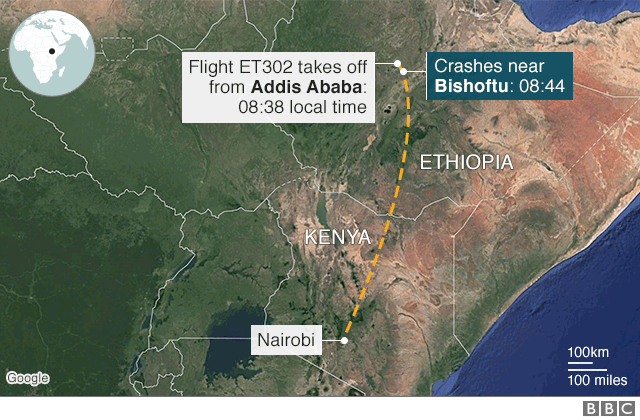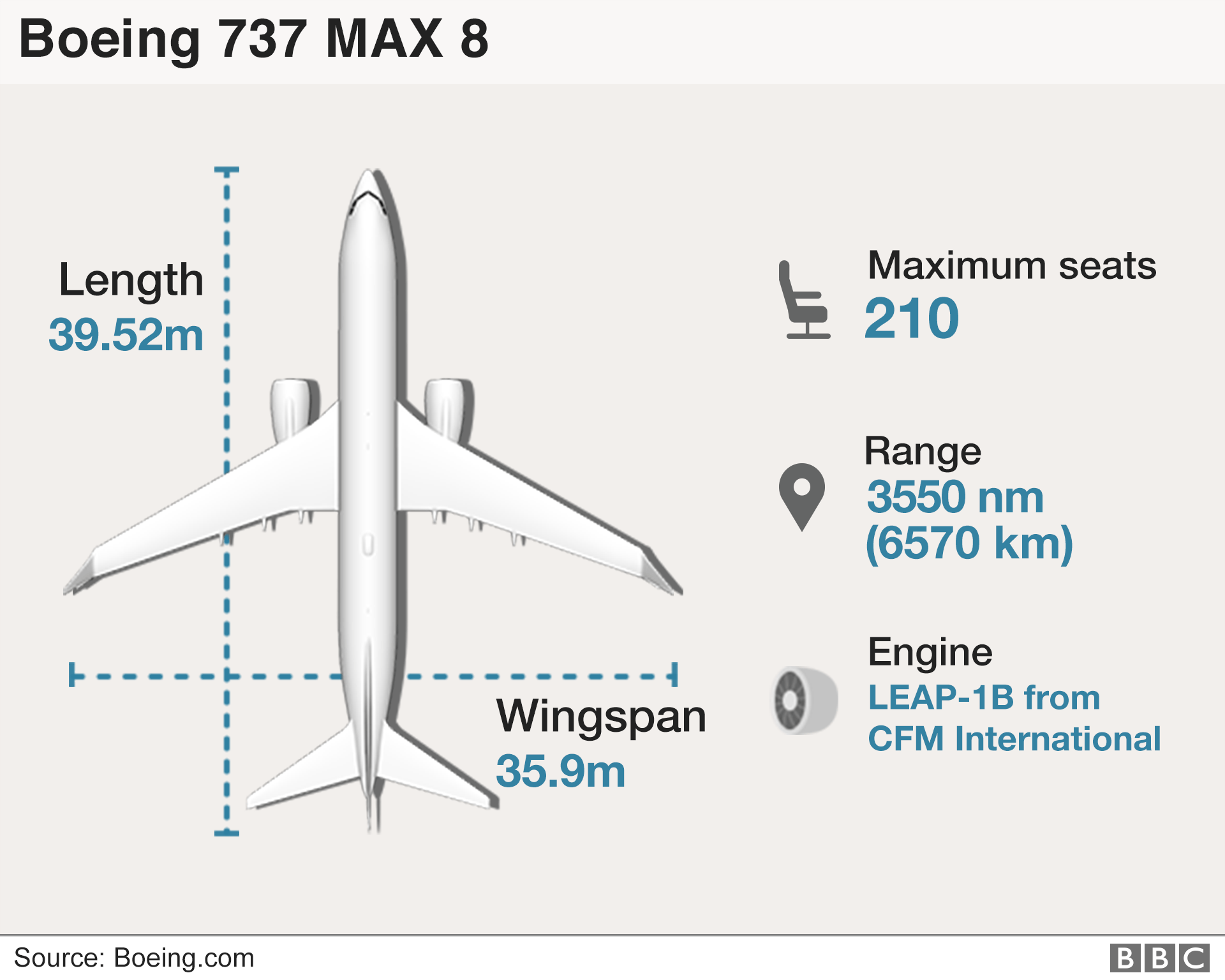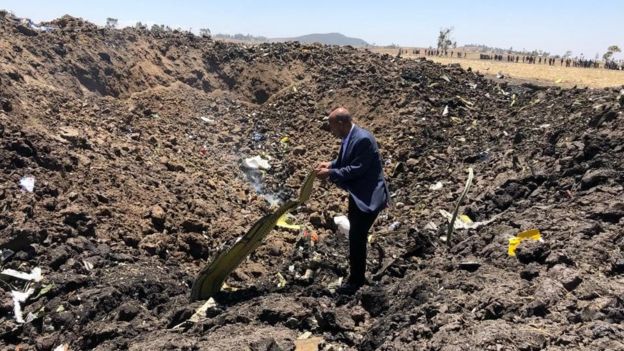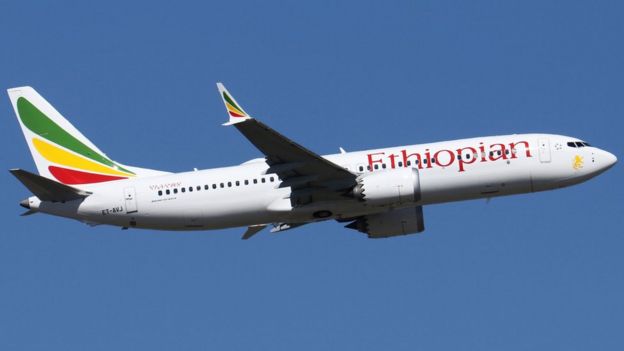Investigators have found the flight data recorders from an Ethiopian Airlines plane that crashed on Sunday.
The devices recovered at the crash site were the Boeing 737 Max 8’s cockpit voice recorder and digital flight data recorder.
The plane was en route from Addis Ababa to the Kenyan capital, Nairobi, when it crashed six minutes after take-off, killing all 157 people on board.
Several airlines have grounded the Boeing model following the disaster.
The months-old aircraft came down near the town of Bishoftu, 60km (37 miles) south-east of the capital at 08:44 local time (05:44 GMT).
- The delay that saved a man’s life
- More about Boeing 737 Max 8
- Ethiopian Airlines: Africa’s largest airline
There were people of more than 30 nationalities on the flight, including Kenyans, Ethiopians, Canadians, and Britons.
Do we know how it happened?
The cause of the disaster is not yet clear. But the pilot had reported difficulties and asked to return to Addis Ababa, Ethiopian Airlines said.
“At this stage, we can’t rule out anything,” CEO Tewolde Gebremariam said. “We can’t also attribute the cause to anything because we’ll have to comply with the international regulation to wait for the investigation.”

Visibility was said to be good but air traffic monitor Flightradar24 reported that the plane’s “vertical speed was unstable after take-off”.
The pilot was named as Senior Capt Yared Getachew who Ethiopian Airlines said had a “commendable performance” with more than 8,000 hours in the air.

Several witnesses who worked in the farmland below the plane’s flight path told the Reuters news agency they heard loud rattling noises coming from the aircraft and saw billows of smoke and debris in its wake as it made a low turn over the fields.
“When it was hovering, fire was following its tail, then it tried to lift its nose,” said one witness, Gadisa Benti. “When it passed over our house, the nose pointed down and the tail raised up. It went straight to the ground with its nose, it then exploded.”
What do we know about the plane?
The 737 Max 8 aircraft has only been in commercial use since 2017.
The plane that crashed was among six of 30 that Ethiopian Airlines had ordered as part of its expansion. It underwent a “rigorous first check maintenance” on 4 February, the airline said.
Boeing said it was “deeply saddened” by the crash and was sending a team to provide technical assistance.
It was the second crash in five months involving a 737 Max 8, and comparisons are being drawn with a Lion Air accident in Indonesia last October that killed 189 people.

Following the Lion Air crash, investigators said the pilots had appeared to struggle with an automated system designed to keep the plane from stalling, a new feature of the jet.
The anti-stall system repeatedly forced the plane’s nose down, despite efforts by pilots to correct this, preliminary findings suggested. The Lion Air plane was also new and the accident happened soon after take-off.
“It’s highly suspicious,” Mary Schiavo, former Inspector General of the US Transportation Department, told CNN. “Here we have a brand-new aircraft that’s gone down twice in a year. That rings alarm bells in the aviation industry, because that just doesn’t happen.”
After last October’s crash, Boeing sent an emergency notice to airlines warning them of a problem with the anti-stall system.

Boeing is expected to release a software patch to the system to deal with the issue, Reuters reports.
It is not yet clear whether the anti-stall system was the cause of Sunday’s crash. Aviation experts say other technical issues or human error cannot be discounted.
Who were the victims?
There were 32 Kenyans, 18 Canadians, nine Ethiopians and seven Britons on the flight, according to a passenger list published by Ethiopian officials.
There were also eight Italians, eight Chinese, eight Americans, seven French citizens, six Egyptians, five Germans, four Indians and four people from Slovakia.

A number of passengers are also believed to have been affiliated with the UN and were travelling to a session of its Environment Assembly in Nairobi.
“It is one of the biggest catastrophes we have had in years,” Michael Moller, director-general of the UN Office in Geneva, told the session on Monday.
UN Secretary-General Antonio Guterres expressed his condolences for the dead. “Our colleagues were women and men, junior professionals and seasoned officials, hailing from all corners of the globe and with a wide array of expertise,” he said.
“They all had one thing in common: a spirit to serve the people of the world and to make it a better place for us all.”
David Beasley, the executive director of the World Food Programme, said seven members of the agency’s staff had died in the crash, including Irish and Italian nationals.
What happens next?
The investigation will be led by Ethiopian authorities in co-ordination with teams of experts from Boeing and the US National Transportation Safety Board.
Ethiopian Airlines said it had grounded all of its 737 Max 8s “until further notice” as “an extra safety precaution”. The airline’s first flight to Kenya since the crash touched down at 10:25 local time on Monday, and a different model of plane was used.

Meanwhile:
- China’s aviation regulator has also ordered local airlines to halt the flights of 737 Max 8s. More than 90 are in use by Chinese carriers including Air China, China Eastern Airlines, and China Southern Airlines
- Indonesia grounded all 737 Max 8s, and Cayman Airways also grounded its two Boeings of the same type
- A spokeswoman for FlyDubai, which operates a number of 737 Max 8s, told Reuters that the company continued to have confidence in the aircraft
- Several North American airlines have said they are monitoring the investigation. Southwest Airlines flies 31 737 Max 8s, while American Airlines and Air Canada each have 24 in their fleet
Shares in Boeing fell by 12.9% in the wake of the crash.

